Sandhya Iyer
In 2010, NASA sent a part of a 360-year-old apple tree to the International Space Station*. This ancient bit of bark came from the same tree that is said to have once dropped an apple before Newton and set him thinking about gravity.
Isaac Newton was a legend in his time and all but deified in the years following his death (in 1727). The inscription on his tomb reads, in Latin, “Mortals rejoice, that there has existed such and so great an ornament of the human race!”
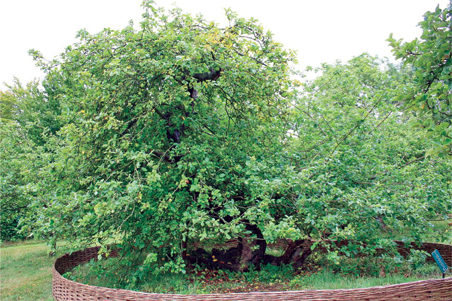
Image source: https://en.wikipedia.org/wiki/Woolsthorpe_Manor#/media/File:Newtons_Apfelbaum.jpg
No doubt his genius and his contributions merit such high praise. But to hear the man described by his peers – and in some cases, even by himself – could the tribute perhaps be a little bombastic?
Newton cast a shadow so long that it wasn’t until the 20th century – when Einstein crafted his laws of relativity – that physicists began moving away from his theories. Einstein revered his predecessor. He especially admired Newton’s ability to turn ideas and conjectures into verifiable hypotheses.
Take the behaviour of smoke for instance… why does it move upwards? Great thinkers going all the way back to the ancient world have sought to explain this commonly observed motion.
Aristotle (384-322 BCE), for instance, believed in four basic elements (earth, water, fire, air) and that like attracted like. He believed that smoke, which is mostly air, chose to move upwards since it was attracted to more air.
Around 600 BCE, the Vaisheshika Sutra by Indian philosopher Kanada described motion (and force) in a manner similar to Newton. This text long remained unknown to the world at large; the earliest extant English translation most likely comes from the late 19th century.
French philosopher René Descartes (1596-1650) devised laws of motion that bore some similarities to some of Newton’s laws. Except, he made god the primary force!
Newton’s fully scientific principles gave the world the first set of testable hypotheses for understanding the movement of everything, from the atomic to the astronomical. Ironically, Newton’s letters show that he hoped his work would lead people to believe in god and strengthen their faith.

Image source: https://commons.wikimedia.org/wiki/File:Isaac_Newton,_English_School,_1715-20.jpg
An apple far from the tree
In the words of historian Mordechai Feingold, “With time… Newton receded into the background, overshadowed by the very legacy he helped create. Newton thus metamorphosed into science personified.”
Salvador Dali, a master of Surrealism, framed this destiny of great men in a sculpture titled Homage to Newton. The statue is a hollowed out figure. Newton’s guts (i.e., his personality) are missing. And his head is the shell of an apple. Essentially, Dali is asking, what is the true face of the man? He who has been stripped of his individuality and become a figure of science.
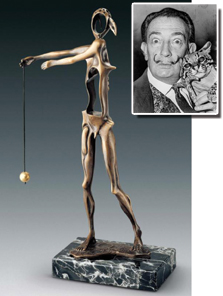
Image source: https://www.daliparis.com/en/gallery-item/homage-to-newton/
Fortunately, Isaac Newton left behind a gargantuan stack of correspondence, notes and manuscripts for scientists and historians to delve into. The trove is estimated at 10 million words; that’s about 150 novel-sized books!
These works, as well as the more conventional portraits of Newton, make him seem like a lofty and formidable scholar. He is easily imagined dressed in fine clothes and the long flowing wig that was fashionable in his day. But for all his later finery, Newton had humble beginnings.
He was born a few months after the death of his father, a farmer. A premature baby, Isaac’s survival was unexpected. Some three years later, his mother remarried and left him at his grandmother’s home. This event, he would later explain, made him feel abandoned. His stepfather tried to make Isaac a farmer, but the gifted child insisted upon attending school… and was eventually allowed to do so.
Newton was just seven years old when King Charles I of England was beheaded by his own people. For the next 11 years, the country became a Puritanical republic under the firm hand of Lord Protector Oliver Cromwell. These were religious times and, his dedication to science notwithstanding, Newton became a deeply religious man. He confessed even to such sins as stealing plums and sugar from his mother, making pies on Sunday, punching his sister and to being a glutton!
Newton eventually enrolled at Cambridge and worked as a servant, cleaning rooms and waiting tables, to pay his way. His views on religion developed as he grew older and he began to disagree with the Church of England’s teachings – secretly. This became problematic when he came up for a fellowship at Cambridge. By this time, he no longer believed in the Trinity or the divinity of Christ and could not swear the oath that was needed. Fortunately, King Charles II (the shrewd and fun-loving prince who restored the monarchy after Cromwell’s death) was persuaded to grant him a special dispensation at the last minute. Newton got his seat in Cambridge. Had his beliefs been made public, he would have been denounced as a heretic and received a seat in the Tower of London!
Anti-gravitas
While Newton proved himself a man of high morals many times, he was also a man of high pride. This often led him into petty, vindictive acts. The scientist who corresponded with many luminaries of his time also fought long, vengeful battles against most of them. In two cases at least, he seems to have won just by outliving his rivals!
The first was Robert Hooke (1635-1703). Hooke added to human knowledge of mechanics, biology, horology, paleontology and various other -ologies. His work is so brilliant and wide-ranging, he has been called England’s Leonardo.
In the 1670s, Hooke was working on a theory about the force exerted by the sun on the planets of the solar system. He discussed his ideas with Newton on a visit to Cambridge. Newton had by then independently worked out his laws, but not published them. Worried that Hooke might steal a march, he quickly moved to publish first.
What followed was a series of escalating complaints and public accusations about who stole whose ideas. The war lasted until Hooke died. Soon after, Newton used his position and influence to destroy Hooke’s only known portrait and remove many of his papers from the Royal Society archives. Though much of Hooke’s works have now been recovered, we still don’t have a portrait of the scientist.
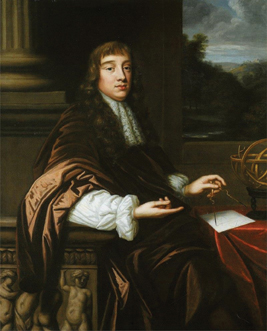
Image source: https://en.wikipedia.org/wiki/Robert_Hooke#/media/File:Portrait_of_a_Mathematician_1680c.jpg
In 1684, Newton entered another battle. This time, with mathematician Gottfried Leibniz over who first came up with calculus. That also lasted years, with both men using their influence to discredit the other, until Leibniz too passed away.
Among the sins that troubled Newton, he confessed to beating Arthur Storer, an astronomer who eventually moved to America. This was not the only troubled relationship he had with an astronomer. John Flamsteed is famous for his observations of Uranus and for being the first Astronomer Royal, a post created by King Charles II. Flamsteed complained that Newton did not properly acknowledge his contributions in Principia Mathematica despite using them to make his discoveries about gravity. A cantankerous Newton deleted all references to Flamsteed’s work in the second edition of his famous manuscript.
Law and order
This unforgiving nature, combined with the religious zeal, led Newton to punish sinners outside academia as well. At the turn of the century, he became the Warden of the Mint (and eventually, Master of the Mint). This was a time when English currency was easily counterfeited. Its hand-stamped silver coins were prone to being clipped off at the edges (thus devaluing the coin). And the men in charge of the Mint were largely lazy and corrupt.
Newton set about fixing this complex situation with the same doggedness he showed in his scientific endeavours and battles. His attention to detail, his pursuit of the criminals – even to the point of visiting taverns in disguise – and bringing evidence to the courts, had a Sherlock Holmes-like quality. But he went a step further. When he found that the justice system was letting the counterfeiters off easy, he became a justice of peace and took charge of prosecuting the cases#. He cross-examined over 200 witnesses, informers and suspects and had a number of the accused executed! Thanks to him, the British currency eventually shifted to its first gold standard.
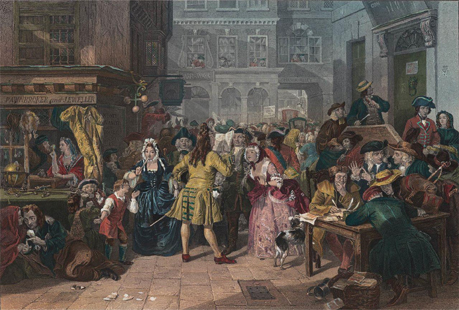
Image source: https://en.wikipedia.org/wiki/South_Sea_Company#/media/File:South_Sea_Bubble.jpg
Q.E.D
Newton joined the academic world when it stood on the cusp of the Scientific Revolution. He developed calculus, invented a powerful new telescope and transformed our understanding of light, optics, gravity and motion… to name just a few of his ground-breaking contributions. As a man, he was often at extremes: he dedicated his life to laying the foundations for strong experimental science, but remained deeply religious. He was secretive and often kept his work under wraps, but was also paranoid about being overlooked. He corresponded with many luminaries of his time, but also fought long, acrimonious battles against most of them.
This complex man was a true match for the complex times in which he lived. Echoing his third law of motion, British poet and painter William Blake framed it thus: “Without contraries [there] is no progression. Attraction and repulsion, reason and energy, love and hate, are necessary to human existence.”
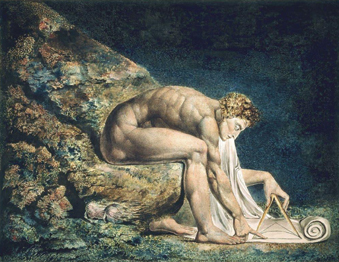
Image source: https://en.wikipedia.org/wiki/Newton_(Blake)#/media/File:Newton-WilliamBlake.jpg
*https://www.theguardian.com/science/2010/may/09/isaac-newton-apple-tree-space
#The law in those days was very different from what it is today. Britain’s first professional police force (the Bow Street Runners) only came into being in 1749, i.e., some 20 years after Newton died. Before that, citizens (especially those with influence) often took the law into their own hands.
The author is a scientist by training and a publisher by profession. Formerly editor-in-chief at Knowello, a business and finance app, and managing editor at Jaico Publishing House, she has travelled from Bollywood to Belgium in pursuit of good content, fresh ideas and talented authors. She is a children’s book author herself and her latest work, Grim Tales of Ancient India, will be out soon from Hachette India. Originally from Kanyakumari, Sandhya writes for a living, learns Japanese for kicks, and collects rare accounts of trade and warfare in coastal states.
